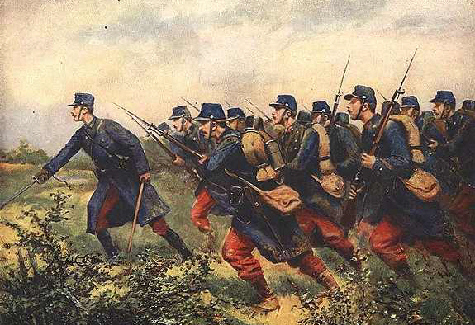 |
| Boer Artillery in South Africa |
There was an observed tendency amongst [British] junior officers during the Boer war to hesitate in pressing the attack, no doubt as a result of the oppressive firepower they faced. At the battle of Colenso in 1899, Boer firepower paralyzed many units, and this was to be repeated numerous times during the conflict. The British fears, therefore, echoed those of their French counterparts: that dispersion tactics [instead of massed assaults] would sap the army of its offensive spirit, which could only find proper expression in the mass assault.
But such anxieties themselves were not sufficient to dictate policy, and after the South African War both the British and French heavily revised their infantry tactical doctrines to reflect the "newfound" supremacy of firepower and to place more emphasis on small-unit tactics. Starting in 1902 British training manuals for all three branches of the army were revised with an emphasis on defensive firepower, and the 1904 revision of French doctrine likewise returned to dispersion, abandoning the coude à coude formation and prescribing advances by small groups covering each other. Certainly the armies possessed the ability to learn, and to learn quickly at that. After the South African War, however, anxieties understandably remained high over untried dispersion tactics, and the impulse to revert to more traditional mass-based tactics was strong.
What was needed to move past the miasma of doubt left by the Boer War was a true field test of the operational capabilities of "naked" infantry through the fire-swept zone—a confirmation one way or the other. The future combatants of World War One received such a test during the Russo-Japanese War from 1904–05. This was an absolutely pivotal moment in the development of prewar tactical doctrine, as the theorists of the time tended to read what they wanted to from the lessons it had to offer. By far the most important lesson taken from it was the general consensus that mass infantry assaults with the bayonet, in spite of the harsh trials of South Africa, were still not only possible but increasingly necessary. As British Brigadier Kiggell remarked, after the Boer War the War Office concluded that firepower was now decisive in battle and that the sword and bayonet were out, "but this idea is erroneous, and was proved to be so in the late war in Manchuria. Everyone admits that. Victory is now won actually by the bayonet, or by the fear of it."
 |
| Japanese Soldiers at Port Arthur Preparing to Attack |
During the Russo-Japanese War, the Japanese infantry repeatedly relied upon the bayonet assault to break through the Russian fire-swept zone and overtake the Russian trenches, and though they sustained grievous casualties doing so, they were successful. One French observer in Manchuria described an assault, which is worth repeating:
The whole Japanese line is now lit up with the glitter of steel flashing from the scabbard...Once again the officers quit shelter with ringing shouts of "Banzai!" wildly echoed by all the rank and file. Slowly, but not to be denied, they make headway, in spite of the barbed wire, mines and pitfalls, and the merciless hail of bullets. Whole units are destroyed—others take their places; the advancing wave pauses for a moment, but sweeps ever onward. Already they are within a few yards of the trenches. Then, on the Russian side, the long grey line of Siberian Fusiliers forms up in turn, and delivers one last volley before scurrying down the far side of the hill at the double.
(General François de Négrier, Lessons from the Russo-Japanese War)
 |
| Russian Soldiers on the Receiving End of a Banzai Attack |
Reports like this demonstrated for Europeans that the Japanese had won battles through moral superiority—their disciplined troops embodied the spirit of the offensive, allowing frontal assaults with the bayonet (supported by artillery fire) to carry them through the fire zone. It "proved" the military superiority of the offensive against the passive and immobile [defenses] of the Russians, despite the advantages that firepower had provided. If it had worked for the Japanese, then surely it would work for French or British soldiers, whose élan and audacity would carry the fight to the enemy, and victory would be won on the blades of their bayonets despite the fire they might face.
The lessons taken from the Russo-Japanese conflict were not taken in a vacuum; this was seen as confirmation of existing doctrines that had wavered after the Boer War, namely that superior morale was the solution to firepower. This found expression in the words of men like the British General Altham:
The assault is even of more importance than the attainment of fire mastery which antecedes it. It is the supreme moment of the fight. . . From these glorious examples it may be deduced that no duty, however difficult, should be regarded as impossible by well-trained infantry of good morale and discipline.
(Howard, "Men Against Fire," International Security Vol.9, No.1,)
 |
| French Infantry Attack, 1914 |
Allied nations therefore extolled—perhaps obsessively—the virtues of the bayonet, exaggerating its importance so as to convey to the soldiers the absolute necessity of forward motion through the fire-swept zone. They were not alone; German tacticians subscribed to similar ideas. German Colonel Balck, in his 1911 treatise on infantry tactics, confirmed that the Russo-Japanese war had proved "beyond the shadow of a doubt" that cold steel was the way to dislodge determined troops.
Source: Over the Top, September 2009

No comments:
Post a Comment